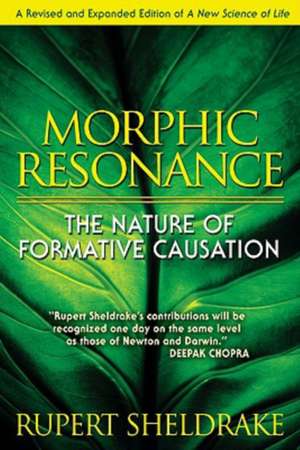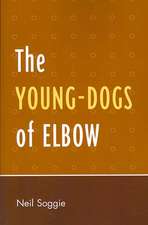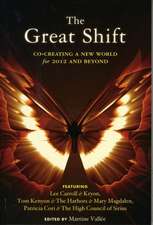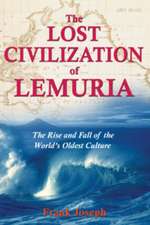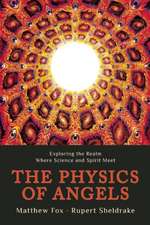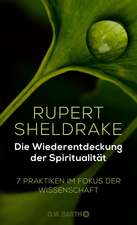Morphic Resonance
Autor Rupert Sheldrakeen Limba Engleză Paperback – 8 sep 2009
Preț: 115.27 lei
Nou
Puncte Express: 173
Preț estimativ în valută:
22.06€ • 23.97$ • 18.55£
22.06€ • 23.97$ • 18.55£
Carte disponibilă
Livrare economică 31 martie-14 aprilie
Preluare comenzi: 021 569.72.76
Specificații
ISBN-13: 9781594773174
ISBN-10: 1594773173
Pagini: 318
Ilustrații: Illustrations
Dimensiuni: 153 x 227 x 21 mm
Greutate: 0.45 kg
Ediția:Revised, Expand
Editura: Park Street Press
ISBN-10: 1594773173
Pagini: 318
Ilustrații: Illustrations
Dimensiuni: 153 x 227 x 21 mm
Greutate: 0.45 kg
Ediția:Revised, Expand
Editura: Park Street Press
Notă biografică
Recenzii
"Sheldrake's theories continue to gain verification, and this book is particularly important because its implications affect the way we view the natural world, as well as ourselves, as one small part of it. "Morphic Resonance" is therefore strongly recommended to anyone interested in understanding current thought about what may lie behind the formation of all natural systems." --New Age Retailer, March 2010
" . . . Sheldrake has steadily developed into one of the world's leading parapsychologists, conducting groundbreaking research in areas where well-behaved scientists fear to tread."--EnlightenNext: The Magazine for Evolutionaries, Issue 46, Spring/Summer 2010
" . . . Sheldrake has steadily developed into one of the world's leading parapsychologists, conducting groundbreaking research in areas where well-behaved scientists fear to tread."--EnlightenNext: The Magazine for Evolutionaries, Issue 46, Spring/Summer 2010
Textul de pe ultima copertă
NEW SCIENCE / BIOLOGY "Books of this importance and elegance come along rarely. Those who read this new edition of A New Science of Life may do so with the satisfaction of seeing science history in the making." --Larry Dossey, M.D., author of Recovering the Soul and Reinventing Medicine "For decades, Rupert Sheldrake has been at the leading edge of highly innovative and controversial ideas about the organization of biological systems. Morphic Resonance poses a serious challenge to traditionalists and is a most welcome book about how we see the world and how we should head off into the future." --Marc Bekoff, author of The Emotional Lives of Animals and Wild Justice: The Moral Lives of Animals "Morphic Resonance is destined to become one of the landmarks in the history of biology. It is rare to find so profound a book so lucidly written." --Bruce H. Lipton, Ph.D., cell biologist and bestselling author of The Biology of Belief: Unleashing the Power of Consciousness, Matter and Miracles When A New Science of Life was first published the British journal Nature called it "the best candidate for burning there has been for many years." The book called into question the prevailing mechanistic theory of life when its author, Rupert Sheldrake, a former research fellow of the Royal Society, proposed that morphogenetic fields are responsible for the characteristic form and organization of systems in biology, chemistry, and physics--and that they have measurable physical effects. Using his theory of morphic resonance, Sheldrake was able to reinterpret the regularities of nature as being more like habits than immutable laws, offering a new understanding of life and consciousness. In the years since its first publication, Sheldrake has continued his research to demonstrate that the past forms and behavior of organisms influence present organisms through direct immaterial connections across time and space. This can explain why new chemicals become easier to crystallize all over the world the more often their crystals have already formed, and why when laboratory rats have learned how to navigate a maze in one place, rats elsewhere appear to learn it more easily. With more than two decades of new research and data, Rupert Sheldrake makes an even stronger case for the validity of the theory of formative causation that can radically transform how we see our world and our future. RUPERT SHELDRAKE, Ph.D., is a former research fellow of the Royal Society and former director of studies in biochemistry and cell biology at Clare College, Cambridge University. He is the author of more than 80 technical papers and articles appearing in peer-reviewed scientific journals and 10 books, including The Presence of the Past, The Rebirth of Nature, and Seven Experiments That Could Change the World.
Cuprins
Preface to the 2009 Edition
Acknowledgments
Introduction
1 The Unsolved Problems of Biology
1.1 The background of success
1.2 The problems of morphogenesis
1.3 Behavior
1.4 Evolution
1.5 The origin of life
1.6 Minds
1.7 Parapsychology
1.8 Conclusions
2 Three Theories of Morphogenesis
2.1 Descriptive and experimental research
2.2 Mechanism
2.3 Vitalism
2.4 Organicism
3 The Causes of Form
3.1 The problem of form
3.2 Form and energy
3.3 The structures of crystals
3.4 The structures of proteins
3.5 Formative causation
4 Morphogenetic Fields
4.1 Morphogenetic germs
4.2 Chemical morphogenesis
4.3 Morphogenetic fields as "probability structures"
4.4 Probabilistic processes in biological morphogenesis
4.5 Morphogenetic germs in biological systems
5 The Influence of Past Forms
5.1 The constancy and repetition of forms
5.2 The general possibility of trans-temporal causal connections
5.3 Morphic resonance
5.4 The influence of the past
5.5 Implications of an attenuated morphic resonance
5.6 An experimental test with crystals
6 Formative Causation and Morphogenesis
6.1 Sequential morphogeneses
6.2 The polarity of morphogenetic fields
6.3 The size of morphogenetic fields
6.4 The increasing specificity of morphic resonance during morphogenesis
6.5 The maintenance and stability of forms
6.6 A note on physical "dualism"
6.7 A summary of the hypothesis of formative causation
7 The Inheritance of Form
7.1 Genetics and heredity
7.2 Altered morphogenetic germs
7.3 Altered pathways of morphogenesis
7.4 Dominance
7.5 Family resemblances
7.6 Environmental influences and morphic resonance
7.7 The inheritance of acquired characteristics
7.8 Epigenetic inheritance
7.9 Experiments with phenocopies
8 The Evolution of Biological Forms
8.1 The neo-Darwinian theory of evolution
8.2 Mutations
8.3 The divergence of chreodes
8.4 The suppression of chreodes
8.5 The repetition of chreodes
8.6 The influence of other species
8.7 The origin of new forms
9 Movements and Behavioral Fields
9.1 Introduction
9.2 The movements of plants
9.3 Amoeboid movement
9.4 The repetitive morphogenesis of specialized structures
9.5 Nervous systems
9.6 Morphogenetic fields, motor fields, and behavioral fields
9.7 Behavioral fields and the senses
9.8 Regulation and regeneration
9.9 Morphic fields
10 Instinct and Learning
10.1 The influence of past actions
10.2 Instinct
10.3 Sign stimuli
10.4 Learning
10.5 Innate tendencies to learn
11 The Inheritance and Evolution of Behavior
11.1 The inheritance of behavior
11.2 Morphic resonance and behavior: an experimental test
11.3 The evolution of behavior
11.4 Human behavior
12 Four Possible Conclusions
12.1 The hypothesis of formative causation
12.2 Modified materialism
12.3 The conscious self
12.4 The creative universe
12.5 Transcendent reality
Appendix A: New Tests for Morphic Resonance
A.1 Bose-Einstein condensates
A.2 Melting points
A.3 Crystal transformations
A.4 Adaptations in cell cultures
A.5 Heat tolerance in plants
A.6 The transmission of aversion
A.7 The evolution of animal behavior
A.8 Collective human memory
A.9 Improving human performance
A.10 Resonant computers
Appendix B: Morphic Fields and the Implicate Order--A Dialogue with David Bohm
Notes
Bibliography
Index of Names
Index of Subjects
